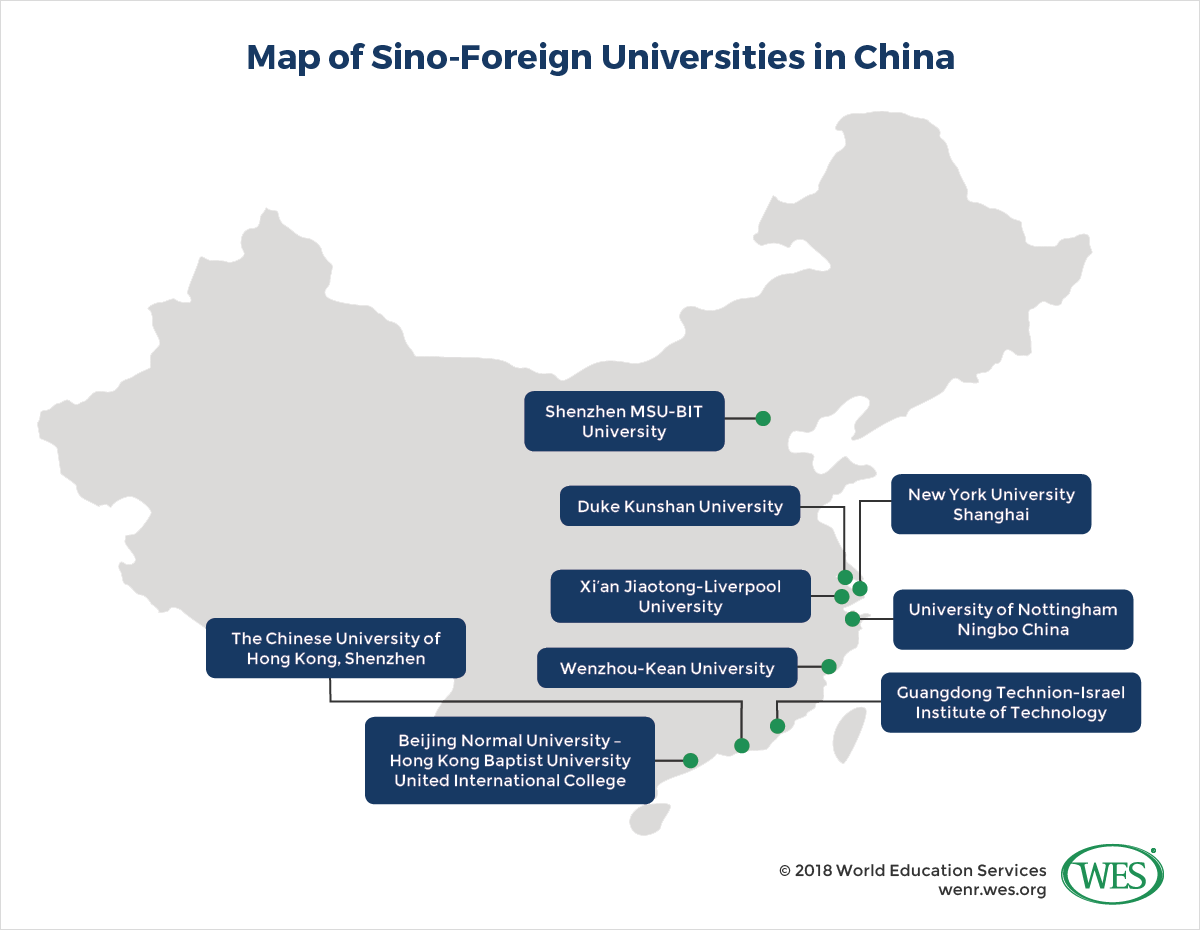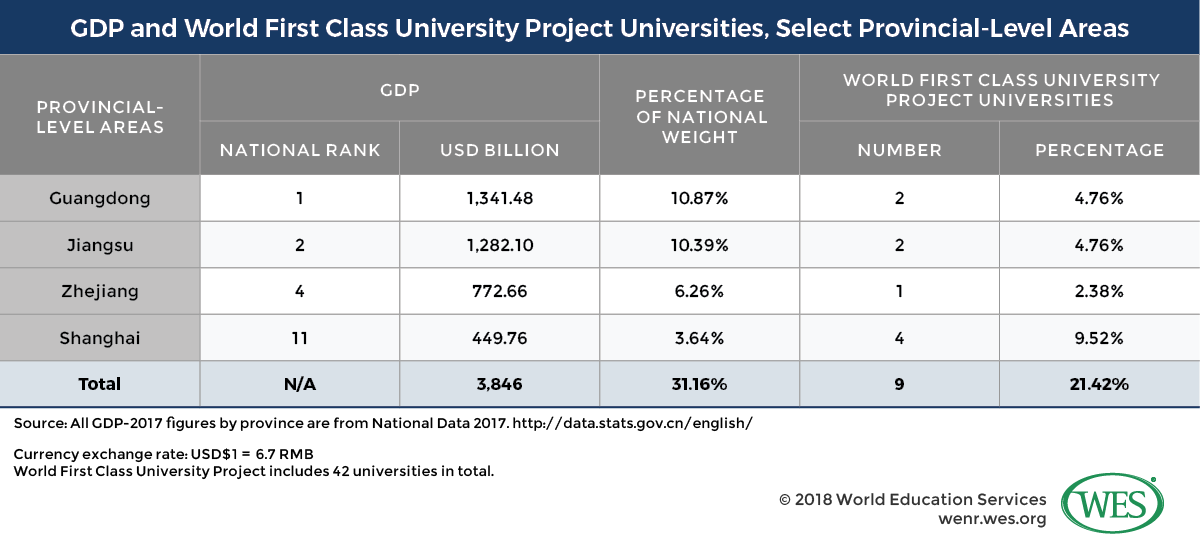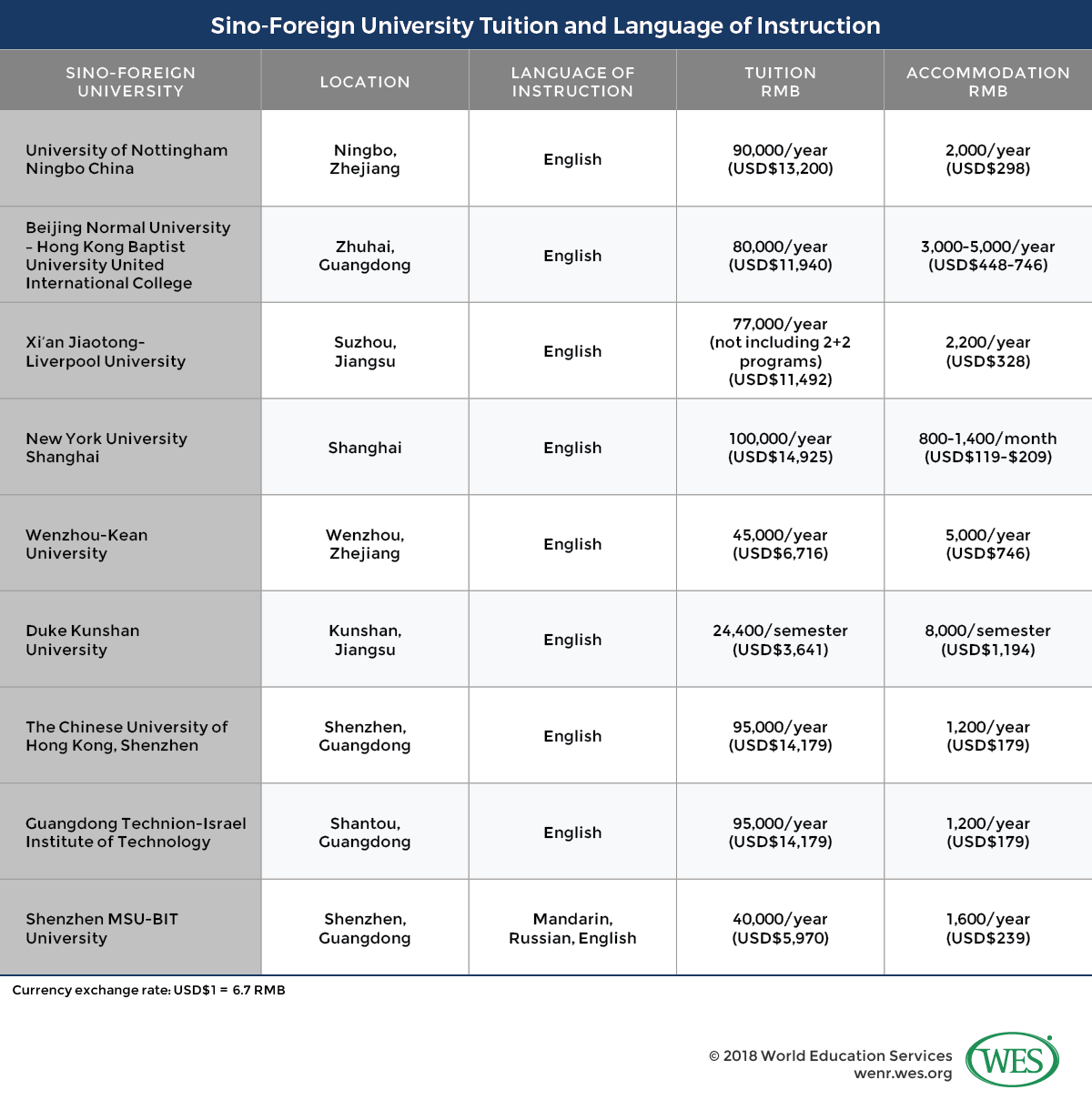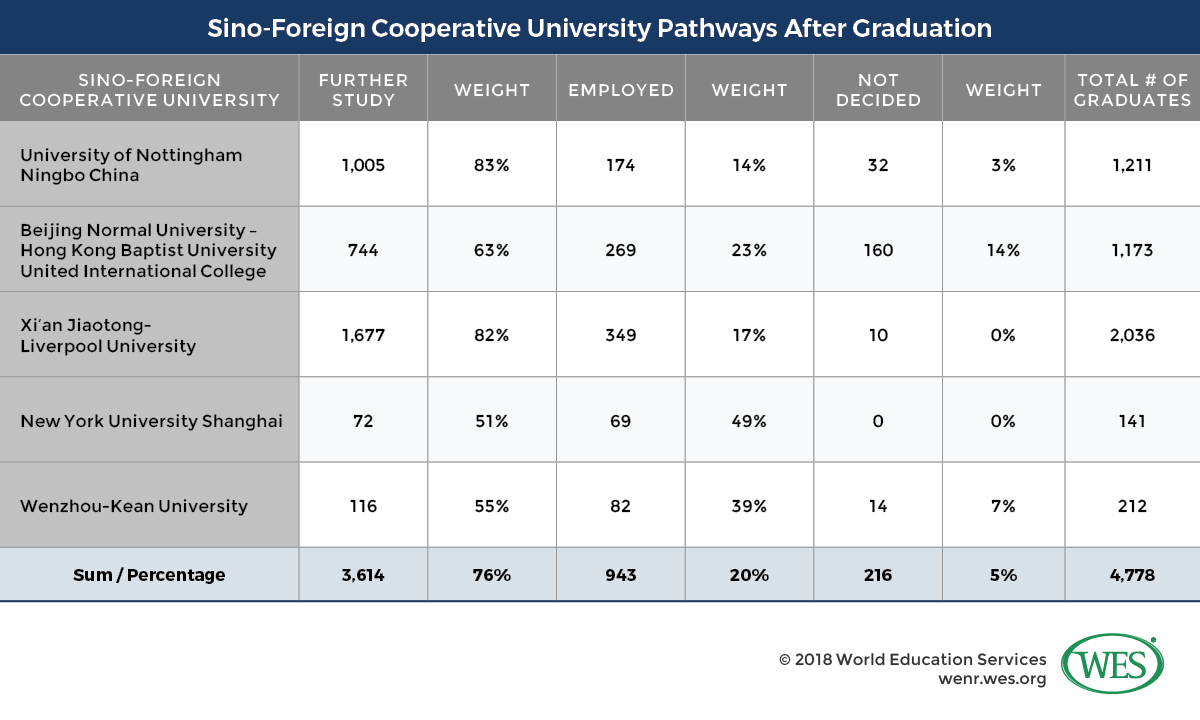Xiao Lu, Senior Marketing Associate, WES
China has been the biggest source country of international students since the 2009/2010 school year. According to a recent Chinese Ministry of Education (MOE) report1 [1], in 2017 more than 608,400 Chinese students—the highest number in China’s history—chose to pursue higher education in a foreign country. With Chinese students’ growing demand for a more diverse educational experience, colleges and universities around the world are looking to establish their presence in China.
Sino-foreign cooperative joint ventures—a flexible legal partnership between Chinese entities and foreign companies—are an effective way that businesses secure a foothold in China. International universities have begun to forge similar partnerships to establish various levels of Transnational Education in China. Even universities in Hong Kong, Macau, and Taiwan must develop joint ventures if they wish to expand their operations in mainland China.
Depending on the scope of the partnership, joint ventures operate on one of three levels of cooperation: the level of the university, institute, or degree:
- At the university level, Sino-foreign cooperative partnerships are the most fully developed. Institutions are literally built—they have their own physical campuses, facilities, and administrations. They are commonly referred to as the Chinese campus of the overseas university. There are currently nine cooperative universities, three with U.S. institutions, that have been approved by the Chinese MOE.
- On an institute level, cooperative projects are attached to an existing local university, but do not have an independent legal status. This is the more traditional branch campus, in which the overseas university provides faculty and support, but classes and facilities are provided as part of the existing Chinese university. As of 2016, there were 66 cooperative institutes in China.
- Cooperative projects can be operated at the degree level as well. In 2016, there were 894 cooperative degree programs offered by Chinese universities.
This article focuses on Sino-foreign cooperative universities, which have partnerships at the university level as described above, and how they differ from domestic Chinese universities. We will also explore pathways and prospects for the graduates of these institutions.
The Nine Sino-Foreign Cooperative Universities in China
In the fall of 2004, the University of Nottingham, a British university, opened a Chinese campus in Ningbo, creating the University of Nottingham Ningbo China (宁波诺丁汉大学, UNNC), the first Sino-foreign cooperative university in China. The new concept started an internationalization trend in Chinese higher education. Eight more Sino-foreign universities followed UNNC’s lead and opened in different areas of China. In 2014, these nine cooperative universities formed the Sino-Foreign Cooperative University Union to unite their voices as a special interest group in Chinese higher education.
In addition to UNNC, the schools are Beijing Normal University – Hong Kong Baptist University United International College (北京师范大学-香港浸会大学联合国际学院,2005), Xi’an Jiaotong-Liverpool University (西交利物浦大学,2006), New York University Shanghai (上海纽约大学,2011), Wenzhou-Kean University (温州肯恩大学,2011), Duke Kunshan University (昆山杜克大学,2013), The Chinese University of Hong Kong, Shenzhen (香港中文大学(深圳),2014), Guangdong Technion-Israel Institute of Technology (广东以色列理工学院,2016), and Shenzhen MSU-BIT University (深圳北理莫斯科大学,2017). By looking at the profiles of each Sino-foreign university’s two host schools—the Chinese institution and its foreign partner—some significant patterns emerge. Consider the host universities’ basic information, such as the year they were established, their location, and their U.S. News & World Report 2018 global ranking:
Both universities can be competitive players in the global rankings. The chart shows that most of these universities have a competitive global ranking. Of the 18 universities, two rank in the world’s top 30, five rank among the top 150, six are in the top 500, and three are among the top 1000. Although global rank is not the only criterion used to evaluate a school, it does indicate the selective decision-making process that goes into qualifying a matching university, for both the Chinese and foreign universities.
Besides being ranked globally, most Chinese universities are ranked as 985 project universities2 [3] or 211 project universities3 [4]—two Chinese MOE efforts begun in the 1990s to recognize and enhance the quality and reputation of Chinese universities. Beijing Normal University, Xi’an Jiaotong University, East China Normal University, Wuhan University, and Beijing Institute of Technology are on both 985 and 211 project lists.
In 2016, in light of China’s goal of improving the global competitiveness of its higher education institutions, the Chinese MOE along with the Ministry of Finance and the National Development and Reform Commission announced the World First-Class University Project,4 [5] also known as the Double First-Class University Project. All five of the universities included on the 985 project list are also included among the 42 standouts in the World First-Class University Project, a goal of which is to significantly increase the number of highly ranked Chinese universities in the global market by the year 2050. With central government support for academic resources, financial backing, and policies that promote this goal, it is expected that in a few years Chinese host universities will see a bump in the global rankings.
Most Chinese host universities were opened more recently than their co-host foreign institutions. As of 2018, the nine foreign institutions have an average age of 143 years, with the oldest, M.V.Lomonosov Moscow State University, at 263 years old; and the newest, the Chinese University of Hong Kong, at 55. In contrast, the average age of the nine Chinese host universities is only 81: the oldest, Xi’an Jiaotong University, has been around for 122 years; and the newest, Shenzhen University, only 35. The foreign universities are nearly 1.8 times older than their Chinese counterparts.
China’s modern higher education system is a relatively recent development, especially compared with that of the West. In 1810, Friedrich Wilhelm Christian Karl Ferdinand von Humboldt (1767–1835) established the very first research-based university, Humboldt University of Berlin5 [6] in Berlin, Germany. It is known as “the mother of all modern universities.”
Although China’s education history can be traced back to the ancient Xia Dynasty (about 2070 BC–1600 BC), it wasn’t until 1895 that China began to establish modern universities nationwide. In that year Imperial Tientsin University, also known as Peiyang University,6 [7] China’s first modern university, was established. Given this later start, Chinese universities especially can benefit from university-level collaborative projects, which provide a platform for the two host universities to learn from each other. Chinese leaders can take what they learn to their home universities, and contribute to efforts toward meeting the goals of the World First-Class University Project.
The Chinese host university is more likely to partner with a higher ranked foreign university. One exception is Beijing Normal University – Hong Kong Baptist University United International College. The foreign institution has a lower rank than its partner Chinese university. Also, U.S. News does not globally rank Kean University nor Zhejiang Wanli University. Besides these exceptions, the Chinese colleges have partnered with higher ranked schools. The widest gap in ranking is between Guangdong Technion-Israel Institute of Technology, whose foreign partner university is 816 places above its host Sino university in the U.S. News global ranking. The narrowest gap is between Shenzhen MSU-BIT University and its foreign university partner, which ranks 224 places above Shenzhen MSU-BIT.
The overseas partners had already successfully opened international branch campuses. In many cases, the Chinese campus is not the foreign university’s very first overseas venture. Before its Ningbo China campus, the University of Nottingham had opened a branch campus in Kuala Lumpur, Malaysia, in 2000. New York University (NYU) opened its first overseas campus in Abu Dhabi, United Arab Emirates, in 2008, financed mainly by the UAE government. Similarly, responding to a call by New York City Mayor Michael Bloomberg, Technion Israel Institute of Technology opened its first overseas campus as part of a joint venture with Cornell University, a U.S. institution. These foreign institutional partners were already actively looking to expand their reputation and capacity onto the global education market.
Most joint campuses are located on the southeast coast of China in the most affluent provinces. As shown on the map below, some joint campuses are built near the Chinese home universities, such as UNNC and NYU Shanghai Campus. Other schools choose to stay geographically close to where their overseas partner campus is. For example, Beijing Normal University – Hong Kong Baptist University United International College is located in Zhuhai, a port city about an hour’s ferry ride from Hong Kong, where Hong Kong Baptist is located. However, some cooperative universities are located far away from both of their host schools.
There are four Sino-foreign universities in Guangdong province, two in Jiangsu province, two in Zhejiang, and one in Shanghai. Among China’s 23 mainland provinces, four municipalities, and five autonomous regions, why do those four regions host more joint schools than other regions do?
Education can be a reflection of local economic development and the demand for research support. According to the National Bureau of Statistics of China,7 [9] in 2017 Guangdong province contributed the top annual GDP value of all the 32 mainland provincial-level areas, closely followed by Jiangsu province; Zhejiang province comes in fourth, and Shanghai, 11th.
The table above shows how the weight of the GDP of these four provinces combined is higher than the weight of World First-Class Universities located in their administrative areas. The four areas have a combined weight of 31.16% in annual GDP, with a lower ratio of 21% World First-Class Universities located in the same area.
China’s capital city, Beijing, has the largest share of World First-Class Universities: eight, or 19.05% of the country’s top higher education resources. After Beijing, Shanghai is the biggest city as well as the economic center of China, with the second-highest number of World First-Class Universities in its administrative districts. Beijing and Shanghai combined have 12 World First-Class Universities—28.57% of overall weight. A lower ratio of education resources is allocated for the rest of the 30 local provinces.
Guangdong, Jiangsu, and Zhejiang are the most economically vibrant areas in China after Shanghai, so there is strong demand in these provinces for a well-educated labor force that has had some international exposure. Also, the provincial governments see the cohosted universities as assets in their local communities. In addition, families from affluent provinces are better able to afford the higher tuition of cooperative universities—another good reason for them to be located there.
How do cooperative universities differ from domestic Chinese universities?
Once approved by the Chinese MOE, Sino-foreign cooperative universities function the same way as other independent universities in China. They recruit mainly local Chinese students who have graduated from high school and taken the Gaokao, China’s National Higher Education Entrance Examination. From a local student’s perspective, or the student’s parents’ perspective, what differentiates a joint university from a traditional local university?
A study abroad experience at your doorstep
Cohosted universities in China provide a foreign education experience for Chinese students right in their home countries. Here is how a Sino-foreign cooperative university delivers a foreign education system in China:
- Classes are taught in English or another foreign language instead of Mandarin. Below is a chart that lists the languages of instruction for the nine cooperative universities. Except for Shenzhen MSU-BIT University, which began admitting students in 2017, all the joint universities teach in English, while domestic Chinese universities use Mandarin almost exclusively. Because learning in an English-speaking environment can be a challenge for Chinese students, some cooperative universities require English language scores in addition to applicants’ Gaokao score. For example, UNNC requires a minimum Gaokao English test score of 1158 [11] out of 150 for undergraduate admission.
- Joint universities use the same curriculum as that of their foreign host universities. All teaching faculty is recruited by the foreign host universities as well, to ensure that teaching quality meets international standards. Some programs have to adapt to local Chinese policies. A traditional Chinese undergraduate degree takes four years; however, a British undergraduate degree typically takes three years. UNNC and Xi’an Jiaotong-Liverpool University both adopted a British curriculum, but they use the extra year for their freshmen to complete a year of English study before starting the degree program in the second year. Their students earn a degree after completing the fourth year of study. A year of English language study helps Chinese students ease into an English language learning environment and get familiar with British academic traditions.
- Sino-foreign cooperative universities also offer a more diverse student profile. Not only do the schools want a diverse student body, but students also want to study with their international peers. When foreign students are looking for opportunities to study abroad in China, Sino-foreign cooperative universities are often their first choice, especially since they teach in English. Among NYU Shanghai’s 300 freshmen every year, about half are international—the other half are domestic students. Diverse students bring different values and cultures together in the classroom, and provide a forum for students to discuss problems on an international level.
- Besides offering a diverse learning experience right in China, cooperative universities usually offer more study abroad or exchange opportunities. Most cooperative universities offer an exchange program that allows students to spend from one semester to one year at their foreign host university. In addition, joint universities may offer 2+2 or 3+1 degree programs. Enrolled students can study on campus in China for the first two or three years, and then finish their academic study at their foreign host university. Students earn academic credit from both the cooperative university in China and the foreign institution. The exchange or study abroad experiences are a bonus for students, especially if they later decide to further their study in a foreign country.
In addition to providing a Western education in a Chinese cultural context, there are other ways that joint universities stand out from traditional Chinese universities.
Students receive two degree certificates when they graduate.
Generally speaking, students who attend a Sino-foreign cooperative university receive both Sino and foreign diplomas when they complete their studies. Usually there is a graduation certificate and a degree certificate issued by the cooperative university itself, and also a degree certificate issued by the foreign host university. UNNC graduates, for example, receive one graduate certificate and one degree certificate issued in Chinese; but they also receive the same English degree certificate as what UK graduates receive. The foreign degrees put these graduates at an advantage since the degrees are recognized around the globe. When graduates apply to overseas schools to pursue further study, their cooperative university degrees carry the same weight as those from the foreign host university. This is a significant advantage that cooperative universities have over domestic institutions in global competitions.
A Sino-foreign university charges higher tuition than a traditional domestic university.
For a Chinese student, domestic universities cost about USD$400–$2,200 in tuition a year.9 [13] Most traditional Chinese universities are public schools; they receive ample financial subsidies from the Chinese central government and the local provincial government, as well as donations from the public and revenues from their own investments. Student tuition contributes only a small portion of university funding.
Unlike domestic Chinese universities, whose various subsidies allow them to keep their tuition low, most Sino-foreign cooperative universities do not receive government funding. As a result, students often pay much higher tuition. The table above lists each Sino-foreign university’s tuition and accommodation fee. Again, unlike Chinese public universities, cooperative universities do not charge a standard tuition, nor do they cap their accommodation fees, so their charges vary. NYU Shanghai charges the most: an annual tuition of ¥100,000 (USD$14,925) and a monthly ¥800-¥1400 (USD$119–$209) accommodation fee, totaling at least ¥109,600 (USD$16,358). Its location in the center of Shanghai, one of the biggest metropolitan areas in the world, is one reason why university costs and student living expenses are higher. Shenzhen MSU-BIT University, which started admissions recruiting in 2017, charges the least: an annual tuition of¥40,000 (USD$5,970) tuition and ¥1,600 (USD$239) accommodation fee. All told, it is much higher than what local Chinese universities charge. In general, any of the above cooperative university’s annual tuition and accommodation fees easily exceed what a student pays at a four-year local public university.
Most joint universities claim that they are non-profit institutions. Tuition is mainly collected to maintain the university’s daily operations and research expenses, not to earn a profit. Given the fact that joint universities have higher human resources expenses because of their globally recruited faculty, travel, and new campus buildings, a higher tuition is expected.
With the growing reputation and recognition of cooperative universities, their tuition rates have increased over the years as well. For example, in 2004, the year UNNC opened, tuition was ¥50,000. Over the next 14 years, UNNC has raised its tuition four times. In its 2018 admissions policy [14], an annual tuition of¥90,000 is listed. In 14 years, the tuition has nearly doubled: It is now 1.8 times what it was in 2004.The tuition is not affordable for every Chinese family. According to Xinhua net,10 [15] in 2017 the average income for Chinese residents is ¥25,974 ($4,033) a year. The tuition for cooperative universities is higher than the average combined income of a two-income family. Cooperative university students and their families are not able to pay the higher tuition out of pocket, but they also recognize the value of cooperative universities, and see it as a wise educational investment.
Higher tuition doesn’t mean lower admissions standards.
A higher tuition means students require greater financial support from their families, but it doesn’t mean a degree can be exchanged for money. In fact, the admission bar at cooperative universities keeps rising. Based on enrolled students’ Gaokao scores, the difficulty of entering a cooperative university can equal that of entering a Double First-Class University.
Every year after GaoKao exam results are released, there are benchmark scores released to sort students based on their Gaokao scores. The highest benchmark score is called the key university admission score (一本线). Students with Gaokao scores that meet or exceed the key university admission score are recognized as the students who have performed the best on the Gaokao, and are eligible to apply to the best universities in China. All the World First-Class Universities, as well as other outstanding Chinese universities, only accept student applications that meet the Gaokao key university admission score. After key university admission score students are admitted, students with lower Gaokao scores are permitted to apply to ordinary universities (二本院校) or associate colleges (专科), based on their benchmark score groups.
A key university admission score is a filter for the best students’ placement into the best universities. Based on a 2018 Gaokao report,11 [16] among 9.76 million Gaokao exam candidates that year, the top 15.15% reached the key university admission score. The previous year’s admission reports indicate that Sino-foreign cooperative universities only accept students whose Gaokao scores meet or exceed the key university admission line that year. Of the nine cooperative universities, the Chinese University of Hong Kong, Shenzhen is one that requires a higher Gaokao score. Its 2016 admissions record12 [17] shows that the average science subject admission score is about 110 points higher than the key university admission score; and the liberal arts subject score is more than 70 points higher, on average. In 2017, on the ranking of Chinese Best College Students’ Source Quality [18],13 [19] the Chinese University of Hong Kong, Shenzhen ranked 29th.
UNNC and Xi’an Jiaotong-Liverpool University raise their admission bar every year, as more students and parents are coming to recognize the value of the cohosted university model. The average science subject admission score in UNNC in 2016 was more than 60 points14 [20] higher than the key university admission score, and the liberal arts admission score was 40 points higher. Xi’an Jiaotong-Liverpool University science admission scores averaged more than 40 points higher than the key university admission score, and the liberal arts admission scores averaged more than 30 points higher.
Meeting the key university admission score is just a starting point for cooperative university applicants. A competitive Gaokao score as well as sufficient family financial support brings students together in cooperative universities.
What are graduates’ prospects after studying at a cooperative university?
MyCos, a higher education management consulting firm in China, issued a report15 [21] on the employment status of 2017 Chinese university graduates. The report shows that six months after graduation, university graduates have an employment rate of 91.9%; 77.1% of them are employed full time, 2.9% are starting their own business, and 10.8% are continuing their study for an advanced degree; 3.4% are still seeking an employment opportunity.
Meanwhile, it has been nine years since the first group of UNNC students graduated from this unprecedented education experience. Which path did these students pursue after leaving UNNC, and did their education prepare them for employment or further study at other academic institutions? In 2017 these five schools, UNNC, Xi’an Jiaotong-Liverpool, Wenzhou Kean, NYU Shanghai, Beijing Normal University – Hong Kong Baptist, awarded degrees to their first graduate cohorts. Below is a chart comparing the different paths taken by students in the class of 2017.
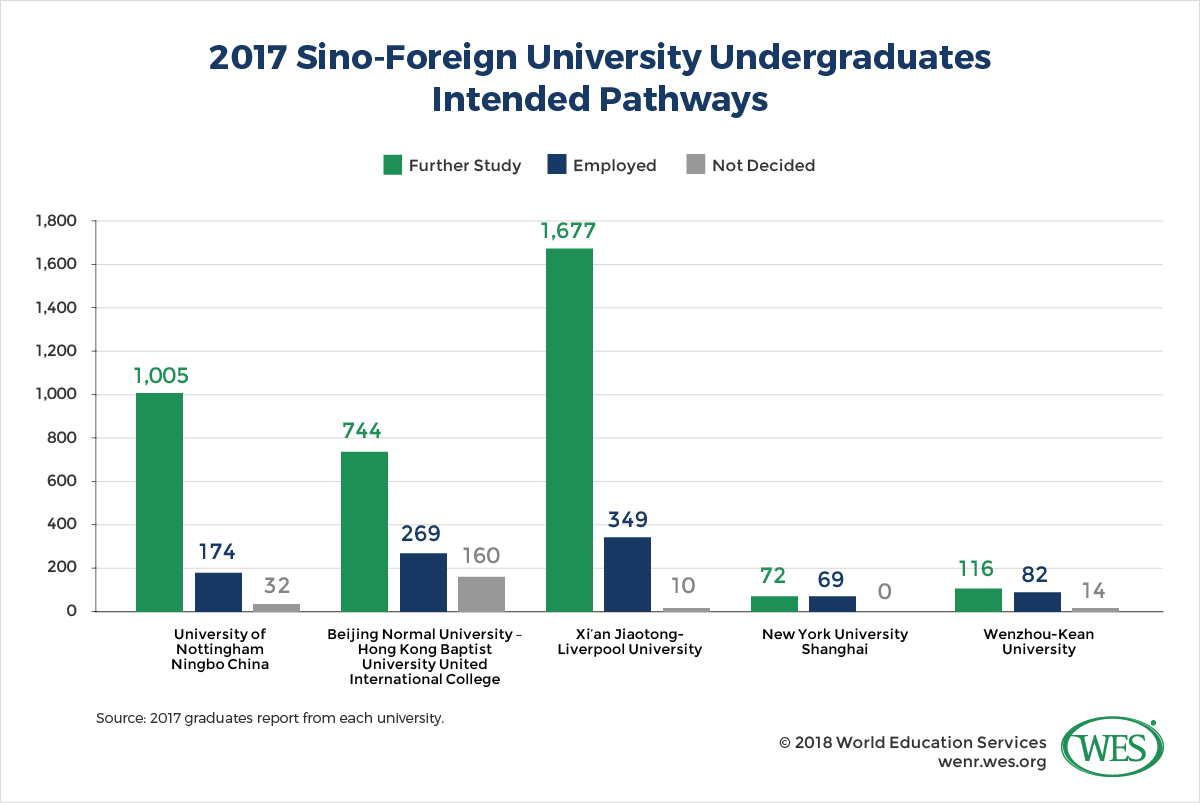 [23]
[23]Source: 2017 graduates report from each university.16 [24]
Note that the Chinese University of Hong Kong, Shenzhen, Guangdong Technion-Israel Institute of Technology, and Shenzhen MSU-BIT University haven’t yet had a graduating class; therefore, data are not available from these three universities.
Compared with graduates of traditional Chinese universities, 10.8% of whom pursued further study, a 76% graduate study ratio makes Sino-foreign cooperative universities stand out.
There may be several reasons for cooperative university students’ greater interest in overseas study. Their Western university experience and English proficiency make their admissions applications stand out from other Chinese applicants. From NYU Shanghai’s 2017 graduates report, half of the graduates received offers from the world’s top 100 universities as ranked by U.S. News. In UNNC’s report, one-fifth of their graduates got offers from the world’s top 10 universities. This is a significant ratio overall. Cooperative universities are recognized as an important bridge if a student is interested in studying abroad for a graduate degree in the future.
Conclusion
It will take time for these new universities to prove their value and build their reputation. There have been many challenges so far, such as the difficulty of recruiting eligible faculty with the desired Western education and academic background, as well as local challenges. For example, the foreign host universities might face obstacles when negotiating either with the Chinese host universities or with local government. The high percentage of Chinese students continuing to study abroad can also be interpreted as a sign that these new graduates may not be as well accepted by Chinese employers yet, so students have to continue polishing themselves overseas.
There are several advantages to the Sino-foreign cooperative university model, however. These institutions bring top foreign and Chinese local universities together, facilitate East-West communication, and pioneer a globally diverse study experience for Chinese students and their international counterparts. Cooperative universities also bring a world-class educational experience into the Chinese education system and increase the diversity of the higher education student body in China.
By providing classes in English, and by exposing students to foreign textbooks, curriculum, and teachers, cooperative universities are able to bring foreign university classrooms onto Chinese campuses. These institutions produce global citizens that are more internationally aware, and add critical talent to contribute to local economic and business growth. Sino-foreign cooperative universities are also a great transition hub connecting local Chinese students to a more expansive study abroad experience.
1. [25] Chinese Ministry of Education “2017 sees increase in number of Chinese students studying abroad and returning after overseas studies” Chinese Ministry of Education. http://en.moe.gov.cn/News/Top_News/201804/t20180404_332354.html [26] (accessed August 9, 2018)
2. [27] China Education Center. “Project 211 and 985.” China Education Center. https://www.chinaeducenter.com/en/cedu/ceduproject211.php (accessed August 9, 2018)
3. [28] China Education Center. “List of Universities in Project 211.” China Education Center. https://www.chinaeducenter.com/en/cedu/cedulist211.php [29] (accessed August 9, 2018)
4. [30] People’s Daily Online. “China to develop 42 world-class universities.” People’s Daily. (accessed August 9, 2018) http://en.people.cn/n3/2017/0921/c90000-9272101.html [31]
5. [32] Humboldt University of Berlin. “The modern classic of the reform university.” Humboldt University of Berlin. https://www.hu-berlin.de/en/about/history [33] (accessed August 9, 2018)
6. [34] Tianjin University. “History and Milestones.” Tianjin University. http://www.tju.edu.cn/english/about/history/milestones/ [35] (accessed August 9, 2018)
7. [36] National Bureau of Statistics of China . “All GDP-2017 figures by province are from National Data.” National Bureau of Statistics of China. http://data.stats.gov.cn/english/ [37] (accessed August 9, 2018)
8. [38] University of Nottingham, Ningbo China. “Mainland Chinese students entry requirements.” University of Nottingham, Ningbo China https://www.nottingham.edu.cn/en/study/undergraduate/entry-requirements/mainland-chinese/index.aspx [39] (accessed August 9, 2018)
9. [40] Classbase. The Cost of College in China. Classbase. https://www.classbase.com/News/the-cost-of-college-in-china-60 [41] (accessed August 9, 2018)
10. [42] Xinhua. “China’s resident income rises 7.3 pct in 2017.” Xinhuanet. http://www.xinhuanet.com/english/2018-01/18/c_136905784.htm [43] (accessed August 9, 2018)
11. [44] Sohu Education. “到底哪些省高考最难?2018年全国各省一本率排行榜发布。” Sohu Education. http://www.sohu.com/a/240372284_99943708 [45] (accessed August 9, 2018)
12. [46] Education Online. “Chinese University of Hong Kong, Shenzhen, Gaokao Admission.” Education Online. https://gkcx.eol.cn/schoolhtm/schoolTemple/school3202.htm [47] (accessed August 9, 2018)
13. [48] 最好大学网. “软科中国最好大学排名-生源质量排名2017.” 最好大学网 http://www.zuihaodaxue.com/shengyuanzhiliangpaiming2017.html [18] (accessed August 9, 2018)
14. [49] Education Online. “University of Nottingham Ningbo China, Gaokao Admission.” Education Online. https://gkcx.eol.cn/schoolhtm/schoolTemple/school1216.htm [50] (accessed August 9, 2018)
15. [51] MyCOS Research. 2018 Chinese College Graduates’ Employment Annual Report. China: Social Sciences Academic Press, 2018.
16. [52] The University of Nottingham Ningbo China. “Annual Quality Report 2016-2017.” The University of Nottingham Ningbo China. https://www.nottingham.edu.cn/en/about/documents/unnc-2016-2017-annual-report-english.pdf [53] (accessed August 9, 2018)
NYU Shanghai. “Graduate Destinations.” NYU Shanghai. https://shanghai.nyu.edu/page/graduate-destinations [54] (accessed August 9, 2018)
Xi’an Jiaotong Liverpool University. “Graduate Destinatios.” Xi’an Jiaotong Liverpool University. http://www.xjtlu.edu.cn/en/study-with-us/why-xjtlu/graduate-destinations [55] (accessed August 9, 2018)
温州肯恩大学. “2017年度毕业生就业质量年度报告.” 温州肯恩大学. http://www.wku.edu.cn/wp-content/uploads/2017/12/%E6%B8%A9%E5%B7%9E%E8%82%AF%E6%81%A9%E5%A4%A7%E5%AD%A62017%E5%B9%B4%E5%BA%A6%E6%AF%95%E4%B8%9A%E7%94%9F%E5%B0%B1%E4%B8%9A%E8%B4%A8%E9%87%8F%E5%B9%B4%E5%BA%A6%E6%8A%A5%E5%91%8A.pdf [56] (accessed August 9, 2018)
北京师范大学-香港浸会大学联合国际学院. “2017届毕业生就业质量年度报告.” 北京师范大学-香港浸会大学联合国际学院. https://uic.edu.hk/cn/public-information/qao/5460-graduates-report [57] (accessed August 9, 2018)


